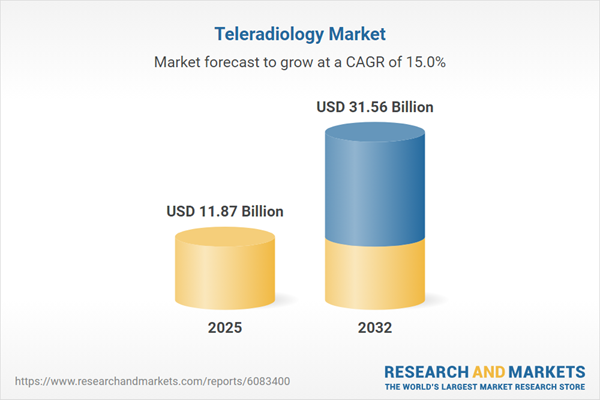Speak directly to the analyst to clarify any post sales queries you may have.
Teleradiology is reshaping clinical workflows by connecting healthcare organizations and specialists across geographic boundaries, enabling remote diagnostic imaging to meet the demands of modern care delivery models. As technology and regulations evolve, senior decision-makers face new imperatives in aligning with a rapidly transforming teleradiology market.
Teleradiology Market Snapshot: Size, Growth, and Outlook
The teleradiology market grew from USD 10.29 billion in 2024 to USD 11.87 billion in 2025 and is forecasted to accelerate at a CAGR of 15.04%, reaching USD 31.56 billion by 2032. This trajectory reflects rapid digital transformation: healthcare providers are increasingly adopting secure, interoperable imaging platforms, while regulatory adaptation and global collaborations support seamless diagnostic service delivery. Digital imaging innovation, artificial intelligence, and high-speed connectivity—including 5G—are driving this growth, helping organizations scale remote diagnostics to meet diverse healthcare demands.
Scope & Segmentation of the Teleradiology Market
This report delivers a comprehensive analysis for leaders navigating the evolving teleradiology landscape. It explores critical market segments, technologies shaping workflows, and key regional variances. Insights help organizations benchmark adoption, anticipate operational challenges, and identify partnership opportunities.
- Modality: Computed Tomography (emphasizing advanced cardiac, body, and neuro CT), Magnetic Resonance Imaging (targeting cardiac, musculoskeletal, and neuro MRI), Mammography, Ultrasound, X Ray, Nuclear Medicine, and Positron Emission Tomography are examined for their technological influences and clinical uptake.
- Application: Core clinical uses span Cardiology (such as coronary assessment and perfusion imaging), Neurology (addressing stroke and tumor detection), Oncology (including breast, lung, and prostate imaging), Orthopedics, and Emergency Medicine, illustrating the value of teleradiology in acute response and specialist care.
- End User: Imaging Centers, Clinics, Community Hospitals, Tertiary Hospitals, and Telemedicine Providers are leading in adoption and devising models tailored to organizational scales and geographic reach.
- Regional Coverage: The market encompasses the Americas (North America and Latin America), Europe, Middle East & Africa, and Asia-Pacific. Each region demonstrates distinct growth dynamics, infrastructure readiness, and regulatory adaptation influencing teleradiology implementation.
- Industry Players: Siemens Healthineers AG, GE HealthCare Technologies Inc., Canon Medical Systems Corporation, Fujifilm Holdings Corporation, Koninklijke Philips N.V., Agfa-Gevaert N.V., Mednax Radiology Services P.A., Teleradiology Solutions LLC, Everlight Radiology Pty Ltd, and NightHawk Radiology Services LLC are assessed as strategic influences and solution providers.
Key Takeaways for Senior Decision Makers
- Artificial intelligence integration streamlines radiologist workflows by enabling automation in triage and prioritization, enhancing productivity and consistency in diagnostic interpretation.
- Cloud-based and high-speed connectivity solutions facilitate rapid, secure sharing of high-resolution images, supporting global collaborations and reducing turnaround times for specialist input.
- Secure image exchange capabilities are addressing workforce distribution challenges and enabling broader patient access, supported by evolving compliance frameworks across regions.
- Regional adoption patterns vary, with certain markets leading in digital infrastructure and others tailoring solutions to compliance and connectivity limitations.
- Subscription-based software models are gaining favor, decreasing reliance on capital expenditures, and helping organizations navigate supply chain and compliance risks.
- Remote diagnostics are foundational in emergency medicine, oncology, and rural outreach, supporting the need for timely specialist support in critical scenarios.
Tariff Impact and Strategic Adaptation
Recent tariff changes in the United States impacting medical devices, cloud solutions, and networking technologies have prompted teleradiology providers to review sourcing strategies and operational models. Typical responses include leveraging regionally hosted clouds, diversifying device procurement partnerships, and reevaluating infrastructure agreements. These strategies support resilience and uninterrupted service within multinational teleradiology networks, ensuring stability against shifting trade and geopolitical landscapes.
Methodology & Data Sources
This analysis synthesizes findings from expert interviews, vendor briefings, regulatory reviews, and clinical case studies. Results are validated through external advisory panels and technology benchmark comparisons to ensure a comprehensive view of the teleradiology sector.
Why This Report Matters in the Teleradiology Market
- Clarifies industry modalities, clinical applications, and geographic trends to support informed investment, strategic planning, and partnership alignment.
- Prepares organizations to manage shifts in regulation, tariffs, and technology, helping to minimize risk and maintain operational continuity.
- Enables identification of emerging growth opportunities and scaling of remote diagnostic capabilities efficiently.
Conclusion
Strategic investment, talent planning, and regulatory awareness are crucial for sustained growth in teleradiology. This report provides actionable insights for leaders navigating the evolving landscape of remote diagnostic imaging.
Table of Contents
3. Executive Summary
4. Market Overview
7. Cumulative Impact of Artificial Intelligence 2025
Companies Mentioned
The companies profiled in this Teleradiology market report include:- Koninklijke Philips N.V.
- Siemens Healthineers AG
- GE HealthCare Technologies Inc.
- Fujifilm Holdings Corporation
- Canon Medical Systems Corporation
- Agfa-Gevaert N.V.
- Mednax Radiology Services, P.A.
- Teleradiology Solutions, LLC
- Everlight Radiology Pty Ltd
- NightHawk Radiology Services, LLC
Table Information
| Report Attribute | Details |
|---|---|
| No. of Pages | 198 |
| Published | October 2025 |
| Forecast Period | 2025 - 2032 |
| Estimated Market Value ( USD | $ 11.87 Billion |
| Forecasted Market Value ( USD | $ 31.56 Billion |
| Compound Annual Growth Rate | 15.0% |
| Regions Covered | Global |
| No. of Companies Mentioned | 11 |









